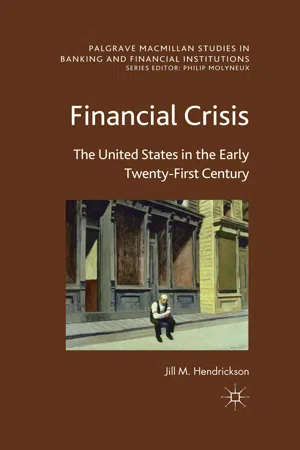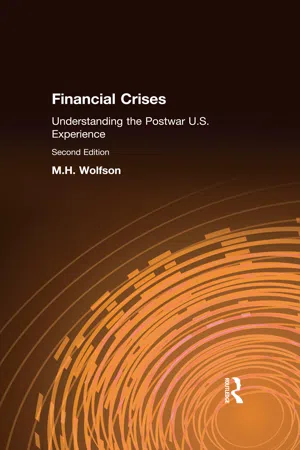Dynamics of Financial Crises
The dynamics of financial crises refer to the patterns and processes that characterize the development and impact of such crises on the economy. This includes the build-up of vulnerabilities, triggers that lead to crisis onset, and the subsequent spread of financial distress. Understanding these dynamics is crucial for policymakers and economists in devising effective measures to prevent and mitigate the impact of financial crises.
5 Key excerpts on "Dynamics of Financial Crises"
- eBook - ePub
Financial Crisis
The United States in the Early Twenty-First Century
- J. Hendrickson(Author)
- 2013(Publication Date)
- Palgrave Macmillan(Publisher)
...In other words, macroeconomic models are empirical in nature and are designed to explain the business cycle. This means that the focus is on understanding fluctuations in output and employment in an economy. The model is necessarily concerned with explaining fluctuations in the whole economy and might (but often does not) include disturbances in the financial sector. In contrast, theories of financial crises explain crisis or turmoil that must include elements of disruption in the financial sector. Further, many theories of financial crises do not treat a crisis as an anomaly but, rather, view the economy as crisis-prone. Financial panic and distress are not new. Some of the earliest speculation and panics occurred in ancient Rome during the second century B.C. At that time, the Roman financial system was relatively well developed with an established credit system. 13 More famous was the tulip bulb panic in the Netherlands in 1636. Several significant panics took place in 1720; two of the most prominent are the South Sea and Mississippi crises. 14 With such experiences came scholars eager to understand and study them. Since the use of credit is central to financial crises, one would assume that crises and their theories came about as a result of the widespread use of credit. However, it is unclear if money predated credit; that is, most monetary theorists today believe that money came first in the evolution of exchange and monetary systems, but this view is far from unanimous. 15 This unresolved issue sheds light on the origins of crises and crises theory. Since crises typically require credit and it is believed that credit has been around almost as long as money, crises has an impressive history. While theories emerged to understand crises, it has not been until the twentieth century that comprehensive, stand-alone theories of financial crisis were articulated...
- eBook - ePub
- Kevin Deane, Elisa van Waeyenberge, Kevin Deane, Elisa van Waeyenberge(Authors)
- 2020(Publication Date)
- Bloomsbury Academic(Publisher)
...10 WHAT CAUSES ECONOMIC CRISES? AND WHAT CAN WE DO ABOUT THEM? Bruno Bonizzi and Jeff Powell Introduction Countries’ growth paths follow the cyclical fluctuations of business activity (so-called business cycles), regularly experiencing slowdown and sometimes entering recessionary periods. A crisis, in contrast, is marked by the suddenness of the descent into recession and the prolonged and often-painful nature of its duration. A crisis can be catalysed by any of a number of factors. Boom and bust in financial asset prices, particularly the stock markets, are a fact of life. Governments around the world, especially the developing world, sometimes run into difficulties servicing their debt. And currencies sometimes fluctuate dramatically, pushing domestic residents into financial troubles. Few crises, however, were as serious as the global financial crisis that started in 2007/08, which, in a way, represented a mix of all the problems described above. It started in a segment of the US financial sector, but financial losses piled up and led major financial institutions to insolvency, first in the US and then internationally. International financial investments declined dramatically, with global investors desperately trying to store their wealth into safe US government bond assets, inducing a generalised global asset price collapse and sharp depreciations of many currencies against the US dollar. Governments were forced to intervene to save insolvent banks, becoming heavily indebted in the process. As this financial meltdown unfolded, the crisis extended to the rest of the economy, consumption and investment collapsed, unemployment rose: a Great Recession ensued in the world economy...
- eBook - ePub
Financial Crises
Understanding the Postwar U.S. Experience
- M.H. Wolfson(Author)
- 2017(Publication Date)
- Routledge(Publisher)
...The key to understanding why the crisis occurs is to be found in the way the supply of credit falls short of the demand. Especially important here is the role of the commercial banks. The crisis itself is a response to these developments which involves a disruption to the financial system. This point is referred to as the credit-market perspective. With this general orientation, it is possible to approach the data in a coherent way. Our interest is focused on developments in the corporate and banking sectors near the peak of the expansion phase of the business cycle. We can look to see if the financial condition of the business sector deteriorates, and how this development affects the banks and the demand and supply of credit. Finally, we can investigate how these events affect the functioning of the financial system. The differences among the various theorists have to do with their specific interpretations within this overall framework. These differences concern (1) the reasons for the development of financial difficulties in the business sector, (2) the factors influencing the demand and supply of credit, and (3) the defining patterns of a financial crisis. By using the discussion of the specific theorists in chapter 2, it is possible to explore each of these differences and compare the various theories. The Development of Financial Difficulties In the latter part of the business-cycle expansion, financial difficulties occur which lay the groundwork for the subsequent financial crisis. Minsky calls this period the systemic development of financial fragility...
- eBook - ePub
- Victor A. Beker(Author)
- 2021(Publication Date)
- Routledge(Publisher)
...9 Financial crises and economic theory Pre-Keynesian models of financial crisis Since the 19th century, economists have developed models to try to explain economic crises. John Steward Mill and Karl Marx, among others, advanced different explanations of these phenomena. Mill asserted that there are recurring periods of “over-trading” and “harsh speculation” followed by periods when establishments are shut up and people are deprived of their incomes. According to Marx, crises are the result of the contradiction between the tendency of the rate of profit to fall and the impetus to accumulate capital. Production accelerates to compensate for the decline in the rate of profit; this finally results in overproduction of commodities and the beginning of crisis. However, financial crises as we know today are essentially a 20th century phenomenon. For this reason, it is perhaps Wicksell the first economist who should be mentioned in connection with the subject of financial crises. In the Wicksellian approach, dynamic economic processes are explained by the interaction of two rates of return, which typically sectionerge. One is the money interest rate and the other one the natural rate of return which is determined in the real sphere. Whenever banks have an excess of reserves, they will decrease the nominal rate of interest to increase their loans. As soon as the money interest rate is lower than the natural interest rate, a cumulative investment process is triggered; the economy will come into a situation of overheating. A money interest rate below the natural interest rate, however, is a disequilibrium phenomenon, signaling to would-be investors a greater willingness than in fact exists on the part of agents in general to sacrifice current consumption for the sake of increasing it later. The money that banks create as they make loans enables those who borrow from them to outbid others for resources, forcing saving upon them...
- eBook - ePub
- Martin Feldstein(Author)
- 2009(Publication Date)
- University of Chicago Press(Publisher)
...Ponzi units are vulnerable to changes in what is believed about future income prospects and to increases in the cost of funds. Financial and Economic Crises This meeting is a roundtable on reducing the risks of economic crisis. The three background papers are on financial, not economic, crisis; furthermore, the papers are not clear on how financial and economic crises are related. The financial instability hypothesis is designed to throw light on the relation between financial and economic crises. The financial instability hypothesis relates finance and aggregate demand through the impact of financial market events upon investment and the impact of investment upon income and on the flows that are capitalized into the price level of capital and financial assets and that are used to fulfill payment commitments. 5 One way financial market events affect investment is by affecting the subjective valuation placed upon I. A rise in the subjective value of I leads to a decline in the money price of capital and financial assets, which are valued mainly for their q ’s, the money income they yield. A fall in these prices lowers the difference between the prices of capital assets and the supply prices of investment output. This will tend to lower investment. Furthermore, a fall in the price of financial assets means that investing units will have to pledge larger future payments in order to obtain a given amount of investment financing...




